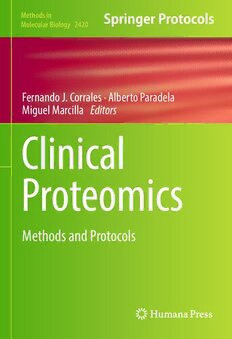
Clinical Proteomics: Methods and Protocols PDF
Preview Clinical Proteomics: Methods and Protocols
Methods in Molecular Biology 2420 Fernando J. Corrales · Alberto Paradela Miguel Marcilla Editors Clinical Proteomics Methods and Protocols M M B ETHODS IN OLECULAR IO LO GY SeriesEditor JohnM.Walker School of Lifeand MedicalSciences University ofHertfordshire Hatfield, Hertfordshire, UK Forfurther volumes: http://www.springer.com/series/7651 For over 35 years, biological scientists have come to rely on the research protocols and methodologiesinthecriticallyacclaimedMethodsinMolecularBiologyseries.Theserieswas thefirsttointroducethestep-by-stepprotocolsapproachthathasbecomethestandardinall biomedicalprotocolpublishing.Eachprotocolisprovidedinreadily-reproduciblestep-by- step fashion, opening with an introductory overview, a list of the materials and reagents neededtocompletetheexperiment,andfollowedbyadetailedprocedurethatissupported with a helpful notes section offering tips and tricks of the trade as well as troubleshooting advice. These hallmark features were introduced by series editor Dr. John Walker and constitutethekeyingredientineachandeveryvolumeoftheMethodsinMolecularBiology series. Tested and trusted, comprehensive and reliable, all protocols from the series are indexedinPubMed. Clinical Proteomics Methods and Protocols Edited by Fernando J. Corrales Proteomics Unit, Centro Nacional de Biotecnología (CNB-CSIC), Madrid, Spain Alberto Paradela Proteomics Unit, Centro Nacional de Biotecnologia (CNB-CSIC), Madrid, Spain Miguel Marcilla Proteomics Unit, Centro Nacional de Biotecnología (CNB-CSIC), Madrid, Spain Editors FernandoJ.Corrales AlbertoParadela ProteomicsUnit ProteomicsUnit CentroNacionaldeBiotecnolog´ıa CentroNacionaldeBiotecnologia (CNB-CSIC) (CNB-CSIC) Madrid,Spain Madrid,Spain MiguelMarcilla ProteomicsUnit CentroNacionaldeBiotecnolog´ıa (CNB-CSIC) Madrid,Spain ISSN1064-3745 ISSN1940-6029 (electronic) MethodsinMolecularBiology ISBN978-1-0716-1935-3 ISBN978-1-0716-1936-0 (eBook) https://doi.org/10.1007/978-1-0716-1936-0 ©TheEditor(s)(ifapplicable)andTheAuthor(s),underexclusivelicensetoSpringerScience+BusinessMedia,LLC,part ofSpringerNature2022 Thisworkissubjecttocopyright.AllrightsaresolelyandexclusivelylicensedbythePublisher,whetherthewholeorpart of the material is concerned, specifically the rights of translation, reprinting, reuse of illustrations, recitation, broadcasting,reproductionon microfilmsorinanyotherphysicalway,andtransmissionorinformation storageand retrieval,electronicadaptation, computersoftware,orbysimilar ordissimilar methodologynow knownorhereafter developed. Theuseofgeneraldescriptivenames,registerednames,trademarks,servicemarks,etc.inthispublicationdoesnotimply, evenintheabsenceofaspecificstatement,thatsuchnamesareexemptfromtherelevantprotectivelawsandregulations andthereforefreeforgeneraluse. Thepublisher,theauthors,andtheeditorsaresafetoassumethattheadviceandinformationinthisbookarebelievedto betrueandaccurateatthedateofpublication.Neitherthepublishernortheauthorsortheeditorsgiveawarranty, expressedorimplied,withrespecttothematerialcontainedhereinorforanyerrorsoromissionsthatmayhavebeen made.Thepublisherremainsneutralwithregardtojurisdictionalclaimsinpublishedmapsandinstitutionalaffiliations. ThisHumanaimprintispublishedbytheregisteredcompanySpringerScience+BusinessMedia,LLC,partofSpringer Nature. Theregisteredcompanyaddressis:1NewYorkPlaza,NewYork,NY10004,U.S.A. Preface Proteomics addresses the study of the proteome or the protein component of biological systems.Itsexponentialtechnologicaldevelopmentinthelast15yearsmakesproteomicsa mature discipline that provides accurate measurements of proteins either in massive or targetedformats.Amongother-omicapproaches,proteomicsoffersunprecedentedoppor- tunities to describe individuals’ phenotypes as proteins translate the genetic information, respondtoenvironmentalperturbationsaswellastreatments,and,ingeneral,mediatemost cellular processes. Therefore, there is an increasing interest in clinical proteomics, an emerging discipline aimed at deciphering the molecular mechanisms underlying the pro- gression of diseases and at the identification of new biomarkers and therapeutic targets to expand the physicians’ toolbox for precision medicine-based patient care. In the following chapters, state-of-the-art clinical proteomics protocols are described in detail for their straightforwardimplementation. Sampleprocessingisakeysteptoensureoptimalperformanceofaproteomicexperiment, especially when clinical specimens must be analyzed. Ciordia et al. describe a method that increasesthebileproteomecoverageandreducestheamountofsamplerequiredbyafactorof sixcomparedtopreviousprotocols.Theinterestinmicrovesicleproteomicshasgrowninthelast fewyearsasitoffersattractiveopportunitiesforclinicalinterventionsinanoninvasivemanner. Hereamethodfortheisolationandcharacterizationofhighlypuremicrovesiclesandexosomes secreted by helminths is described and provides the basis for the discovery of new vaccine candidates against these devastating infections. Biofluid analysis represents a challenge for proteomicsduetothepresenceofveryhighabundanceproteinsthathamper thedetectionof mediumandlowabundanceproteins.Amethodispresentedthatallowsdetectionofmorethan 3000cerebrospinalfluidproteinsandoffersapowerfultoolforprofilingavarietyofcomplex biofluid samples and clinical specimens. In a similar way, enhanced quantitative LC-MS/MS proteomeanalysisfromdriedbloodspotsisdescribedusingsodiumcarbonateprecipitationand adata-independentacquisitionmode.Thestudyofhumangutmicrobiotausingametaproteo- mics strategyhascaptured the attention of the life sciencescommunity as increasing evidence shows its association with human health and disease. An optimized protocol to prepare feces samplesforaproteomicsanalysisisdescribed.Theincreasingsensitivityandaccuracyofstate-of- the-artmassspectrometersmakepossiblesingle-cellproteomicsanalysis.However,optimized sample processing workflows are needed to ensure good recoveries throughout the whole process.Atypicalexampleofmassspectrometry-basedsingle-cellproteomicsworkflowallowing quantification of >1000 proteins is described. Details about the critical steps of analysis and alternativemethodsusefulforoptimizationpurposesarediscussed. Understanding the dynamics of protein post-translational modification patterns and howthisassociateswithpathogenicprocessesisapriorityinclinicalproteomics.Amethodis described to identify lysine acetylation sites and estimate their site occupancy at the prote- ome scale. The procedure has been applied to cell line cultures and to clinically relevant samples stored as both snap-frozen and formalin-fixed paraffin-embedded tissues. A label- free mass spectrometry protocol for proteomic and phosphoproteomic analysis compatible withroutineanalysisofclinicalsamplesisprovided.Theauthorsalsooutlinebioinformatic v vi Preface pipelinesbasedonstatisticallearningthatusetheseproteomicsdatasetsasinputtoquantify kinase activities and predict drug responses in cancer cells. Finally, in this section, an optimized method to enhance the number of proteome-wide citrullinated residues confi- dentlyidentifiedisprovided. The analysis of the peptide repertoire displayed by HLA molecules has been widely appliedtoresearchonautoimmunedisordersandviralimmunology.Morerecently,theuse of immunopeptidomics has been adopted by the cancer research community aiming to detect neoantigens that might promote the development of personalized vaccination pro- cedures.HerewedescribeaprotocoltoprocesshumanthymussamplestopurifyHLAclass I-orHLA-DR-associatedpeptidomes.Thedevelopmentoftoolsthatenablethedeconvo- lution of immunopeptidomes in the context of disease can help to improve the specificity andeffectivenessoftherapeuticstrategiestargetingthesepeptides.Inthisregard,acompu- tational workflow that facilitates the processing and interpretation of Data-Independent Acquisition Mass Spectrometry of HLA peptides is presented. In addition to conventional non-modified peptides, immunopeptidomes also contain phosphorylated species, which maybeofgreatinterestforpersonalizedcancerimmunotherapy.Here,weprovideadetailed protocoltoidentifyphosphopeptidesdisplayedbyhumanHLAclassImolecules. Targeted proteomics has a tremendous potential to quantify specific proteins in the biomedical and clinical domains. Biomarker validation initiatives and patient stratification programs based on protein panels for which there are no reliable antibodies available might greatly benefit from this technology. A protocol is described to quantify 13 enzymes of the one-carbonmetabolism (1CM)in liver tissue specimens. Since1CM impairment in hepato- cytes is a recognized factor associated with chronic liver disorders and hepatocellular carci- noma,thismethodprovidesausefultooltofollowuptheprogressionofthediseaseandassess itsseverityinpatients.Otherclinicallyrelevantmethodologyinclinicalproteomicsismatrix- assistedlaserdesorption/ionization(MALDI)imagingmassspectrometry(IMS)thatallows for the analysis of the spatial distribution of peptides, small proteins, and other molecules withinbiologicaltissues,enablingtheso-called“molecularhistology.”Achapterfocusingon theapplicationofthistechnologytotheanalysisofcryopreservedsamplesisincluded.Tissue imaging is typically associated with antibody-based methods such as immunohistochemistry thatallowfor theexplorationofproteinexpressionatsingle-cellresolutionwithintheintact tissue environment. The entire workflow utilized within the Human Protein Atlas, from sample preparation to annotation of the IHC staining patterns, is described in detail, with important notes onvarious factors that can affect the outcome of IHC. MALDI-TOF mass spectrometryhasbeenappliedwithhugesuccesstotheidentificationofculturedmicroorgan- ismsinClinical Microbiologylaboratories, whereithasbecomethegoldstandardduetoits simplicity, speed, and high reproducibility. Different procedures used in the routine for ® pathogenidentificationusingtheBrukerMALDIBiotyper systemaredescribed. Lastbutnotleast,twoemergingmethodologiesthatwillprobetheirrelevanceinclinical proteomicspipelinesarerevised.Protein-proteininteractionnetworksmustbedescribedin detailtofullyunderstandcellbiologyanddisease.Structuralbiologyhasrecentlywitnessed the benefits of the combined use of two complementary techniques: electron microscopy (EM)andcross-linkingmassspectrometry(XL-MS).Theprotocoldescribedhereispartic- ularlywellsuitedfor thestudyofproteincomplexeswhoseintrinsicallyflexibleor transient nature prevents their high-resolution characterization by other structural techniques. Preface vii Finally, omics integration is needed to discover inter-omics interactions and regulatory changes, which are not observed when analyzing a single omic profile. The multi-omics approach, therefore, provides additional insights to help understand and treat complex diseases. In this book, proteogenomics data integration is discussed, and an overview of thedifferentomiclayersinvolvedindefiningtheproteomeofalivingorganismisprovided. Madrid,Spain FernandoJ.Corrales AlbertoParadela MiguelMarcilla Contents Preface ..................................................................... v Contributors................................................................. xi 1 BileProcessingProtocolforImprovedProteomicAnalysis................... 1 SergioCiordia,GloriaAlvarez-Sola,Marı´aRulla´n, Jesu´sM.Urman,Matı´asA.A´vila,andFernandoJ.Corrales 2 MS-BasedExtracellularVesicle(EVs)Analysis:AnApplication toHelminth-SecretedEVs ............................................... 11 JavierSotillo 3 ProteomicProfilingofCerebrospinalFluidby16-PlexTMT-Based MassSpectrometry...................................................... 21 KaushikKumarDey,HuanSun,ZhenWang,MingmingNiu, HongWang,YunJiao,XiaojunSun,YuxinLi,andJunminPeng 4 Data-IndependentAcquisitionMassSpectrometry-BasedDeep ProteomeAnalysisforHydrophobicProteinsfromDriedBlood SpotsEnrichedbySodiumCarbonatePrecipitation ......................... 39 DaisukeNakajima,OsamuOhara,andYusukeKawashima 5 SampleProcessingforMetaproteomicAnalysisofHumanGut Microbiota............................................................. 53 CarmenGarcı´a-Dura´n,RaquelMartı´nez-L(cid:1)opez, Lucı´aMonteoliva,andConchaGil 6 MassSpectrometry-BasedAnalyticalStrategyforSingle-Cell Proteomics............................................................. 63 A´kosVe´gva´ri 7 LysineAcetylationStoichiometryAnalysisattheProteomeLevel............. 73 JeovanisGilandSergioEncarnaci(cid:1)on-Guevara 8 ImplementationofClinicalPhosphoproteomicsandProteomics forPersonalizedMedicine................................................ 87 PedroCasado,MaruanHijazi,HenryGerdes, andPedroR.Cutillas 9 pH/Acetonitrile-GradientReversed-PhaseFractionationofEnriched Hyper-CitrullinatedLibraryinCombinationwithLC–MS/MSAnalysis forConfidentIdentificationofCitrullinatedPeptides........................ 107 AnetaStachowicz,NivedaSundararaman,VidyaVenkatraman, JenniferVanEyk,andJustynaFert-Bober 10 PurificationofHLAImmunopeptidomesfromHumanThymus.............. 127 In˜akiAlvarez 11 GenerationofHLAAllele-SpecificSpectralLibrariestoIdentify andQuantifyImmunopeptidomesbySWATH/DIA-MS .................... 137 KevinKovalchik,DavidHamelin,andEtienneCaron ix x Contents 12 ImmunopeptidomicAnalysisofthePhosphopeptidomeDisplayed byHLAClassIMolecules ............................................... 149 MiguelMarcilla 13 DevelopmentofaStandardizedMRMMethodfor theQuantification ofOneCarbonMetabolismEnzymes ..................................... 159 LauraGuerrero,AlbertoParadela,andFernandoJ.Corrales 14 MolecularHistologyAnalysisofCryopreservedTissue UsingPeptide/ProteinMALDI-TOFImagingMassSpectrometry (MALDI-IMS) ......................................................... 177 IbonIloro,IraideEscobe´s,MikelAzkargorta,andFe´lixElortza 15 TheHumanProteinAtlasandAntibody-BasedTissueProfiling inClinicalProteomics................................................... 191 BorbalaKatonaandCeciliaLindskog 16 MicrobialIdentificationintheClinicalMicrobiologyLaboratory UsingMALDI-TOF-MS ................................................ 207 Iva´nBloise,M.TeresaCorcuera,JulioGarcı´a-Rodrı´guez, andJesu´sMingorance 17 CombiningElectronMicroscopy(EM)andCross-LinkingMass Spectrometry(XL-MS)forStructuralCharacterizationofProtein Complexes............................................................. 217 Lucı´aQuintana-Gallardo,Moise´sMaestro-L(cid:1)opez,JaimeMartı´n-Benito, MiguelMarcilla,DanielRutz,JohannesBuchner,Jose´M.Valpuesta, andJorgeCue´llar 18 AccuratePredictionofProteinSequencesforProteogenomicsData Integration............................................................. 233 YanickPacoHagemeijer,VictorGuryev,andPeterHorvatovich Index ...................................................................... 261
